Fashion History Lesson: Levi's 501 Jeans
- Oops!Something went wrong.Please try again later.
Welcome to Fashion History Lesson, in which we dive deep into the origin and evolution of the fashion industry's most influential and omnipresent businesses, icons, trends and more.
On May 20, an icon turned 150.
This year, Levi's celebrates the 150th anniversary of when its founder, Levi Strauss, and a tailor from Reno, Nevada received a patent for the process of riveting pants — i.e. adding a metal bolt to bind the fabric together, which made clothes more secure in areas on the receiving end of a lot of pulling and stress. It was a significant turning point in how we make clothes, specifically workwear. And it gave rise to one of the brand's biggest, consistent hits: the 501 jean.
"As much as it's evolved and been tweaked at times, it's so recognizable and identifiable," says Karyn Hillman, the chief product officer at Levi's. To this day, Levi's doesn't like to mess with the 501 much: "We're really thoughtful and respectful of the tenets of the 501 — the button-fly closure, the shrink-to-fit fabric, the tabs, the copper rivets. We basically shepherd the tenets through the process and keep tethered to that."
Levi's considers the 501 its best-selling fit of all time. (The company is projecting total net revenue for the 501 product family to reach $800 million in FY2023.) It's equally popular on the secondhand market: The 501 represented "nearly half of all Levi's jeans orders on Vestiaire Collective" in 2021 and 2022, according to Sophie Hersan, the site's fashion director; in April 2023, searches for the 501 were 99% higher than those for 511s, 505s and 721s on the platform.
It's evolved from a single pair of "overalls" into a whole category of styles, all anchored in those design features first introduced a century and a half ago. Ahead, read about the history of the 501, from the patent that started it all to its enduring appeal.
The origins of the 501
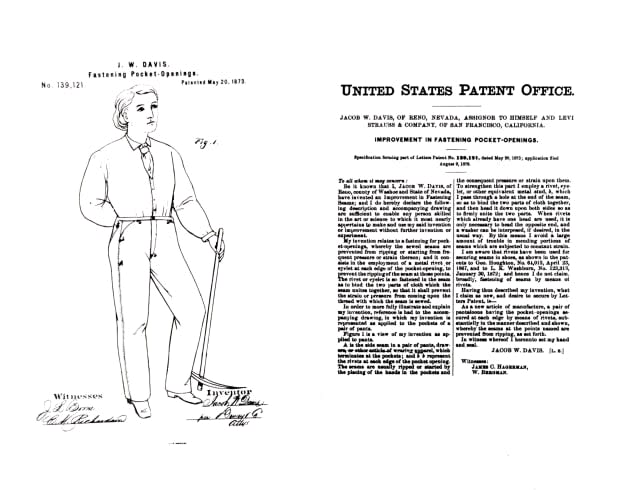
Photo: Levi Strauss & Co. Archives/Courtesy of Levi's
The idea for what became Patent #139,121 originates from the aforementioned tailor, Jacob Davis. At the time, Strauss operated a successful wholesale business out of San Francisco. Davis was one of his clients.
"He was living in Reno, close to Virginia City, where the Comstock Lode had been discovered, and that meant that there were lots of people moving to that area for work, who needed tough pants," says Tracey Panek, the in-house historian at Levi's. "The story goes that Davis had been asked by a woman whose husband needed some tough work pants to create a pair that could fit and not tear. He'd been working on a horse blanket using metal to attach it to a saddle, and he had the idea: What if I take a little bit of the metal and add it to the pockets?"
Davis started making these pants in small batches, and would continuously sell them out. "He couldn't keep up with the demand," says Panek. "That's when he eventually wrote a letter to his fabric supplier."
He wrote Strauss of his invention, and sent two "samples" of the riveted pants: one made out of denim, the other out of duck cloth — both popular workwear materials at the time. "Davis must have been pretty savvy in terms of understanding that he needed someone who could help him create a network, and also someone who was willing to take a good idea and go with it," Panek says. "This would've been some 20 years after Levi had arrived in San Francisco, and had a network all over the American West. And being an experienced businessman, he was willing to take a risk."
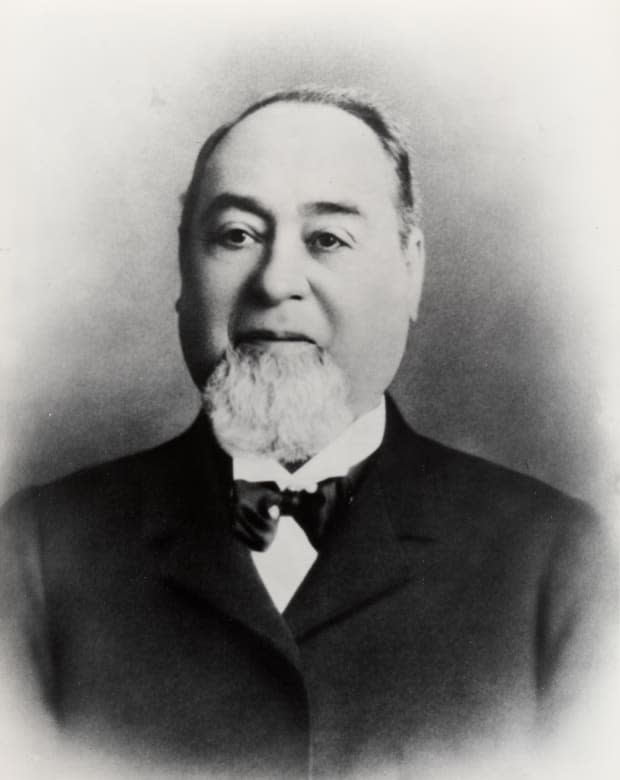
Photo: Levi Strauss & Co. Archives/Courtesy of Levi's
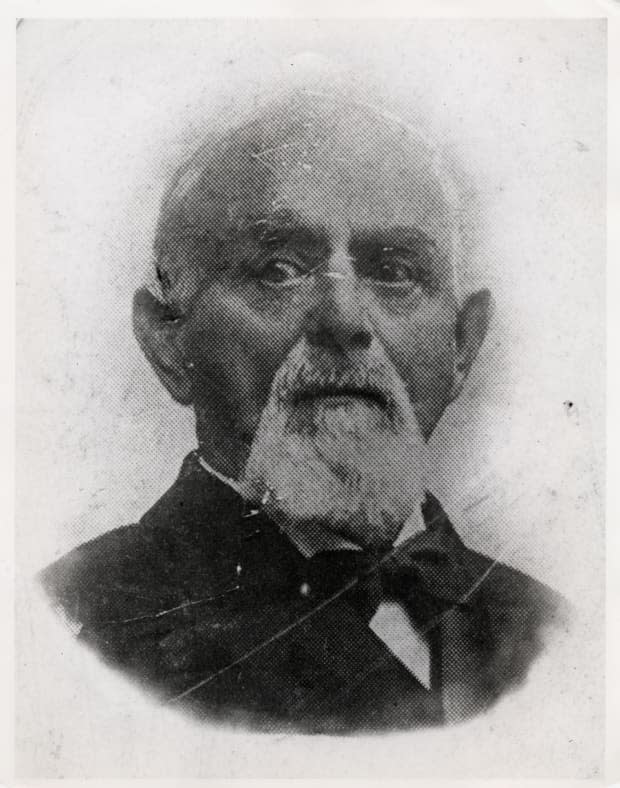
Photo: Levi Strauss & Co. Archives/Courtesy of Levi's
At the time, Strauss operated strictly in wholesale, but he found someone who could manufacture the riveted pants for them. They applied for the patent, and, months after it was granted, Levi Strauss & Co. started selling the pants. (So, in addition to being the first riveted pant, the 501 was Levi's first proper product.)
The pants had rivets, of course, as well as a single back pocket with Arcuate stitching (that's the stitch design you see on pockets), a watch pocket and a button fly. There was also a cinch at the back, to tighten the fit when wearing overalls, and buttons for suspenders.
"I will refer to them as the original baggy pant, because they were just big and oversized, and intended to be that way because they could fit on various body shapes, especially if you were a mining company and men were coming in, wearing the same pair, taking it off and putting it on a peg until the next shift," Panek explains.
In 1886, Levi's added the now-famous leather patch with the drawing of two horses pulling apart a pair of pants, trying to break them apart, to illustrate the garment's durability.
The early 501s: "waist overalls"
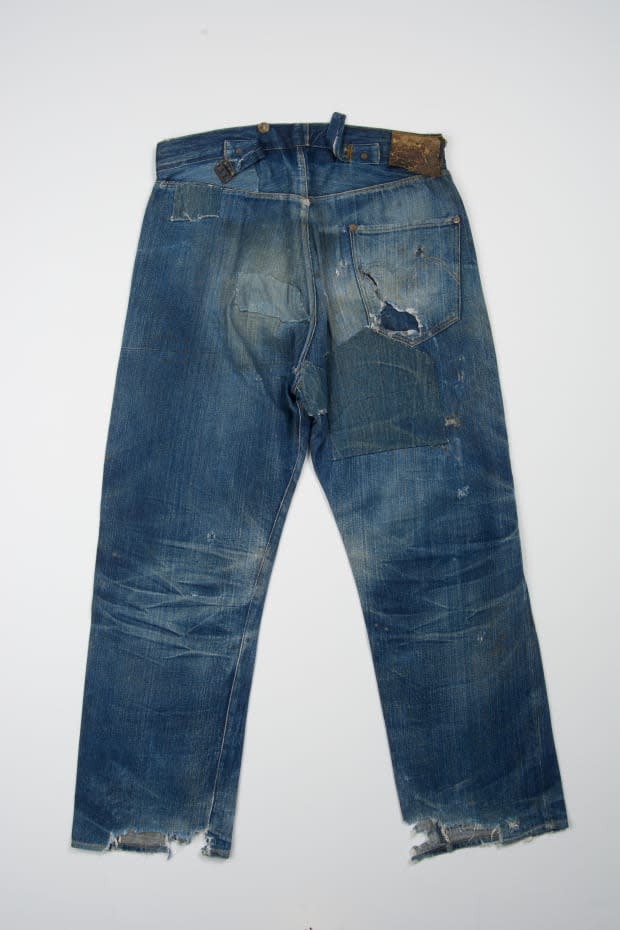
Photo: Levi Strauss & Co. Archives/Courtesy of Levi's
While denim has a long history before Strauss and Davis came in, Daniel James Cole, adjunct assistant professor at the Fashion Institute of Technology and co-author of "The History of Modern Fashion," argues that the partnership was nonetheless brilliant.
"Anybody who'd been [mining for] gold wearing wool — that clothing would've just rotted. By giving them this heavyweight twill weave cotton, they would withstand much more wear and tear, and they dry faster," he says. "Strauss's ability to recognize the market niche and tap it is one of the greatest in fashion's history."
At first, Levi's made the riveted pants out of both denim and duck cloth (a heavy cotton canvas) but quickly discontinued the latter. Panek theorizes it had to do with how the denim hid dirt stains better: "If you're an outdoor worker and you're in mud and around dust, those stains just aren't going to show as much."
The denim came from the famous Amoskeag Manufacturing Company in Manchester, New Hampshire. They weren't called jeans, or even 501s: They were marketed as "waist overalls," since men would put them on over their actual clothes when they went to work.
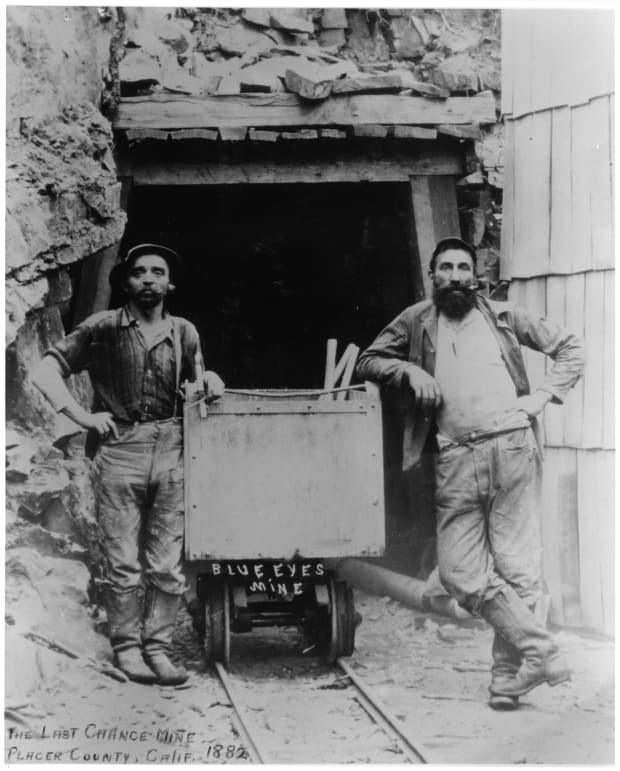
Photo: Levi Strauss & Co. Archives/Courtesy of Levi's
When the patent on riveted pants became public domain in 1890, Levi Strauss & Co. started referring to its products by lot numbers, to have its styles stand out in the market. That's how the 501 got its name. (The reason for the specific number, we don't know: The Great San Francisco Earthquake of 1906 caused massive devastation, including a fire that destroyed Levi Strauss & Co.'s headquarters and factory — and many of the records that might have held the answer.)
Also in the late 19th century, the U.S. saw an influx of immigration from China, which resulted in growing anti-Chinese sentiment and racist legislation, like the Chinese Exclusion Act in 1882 — the first piece of legislation in American history to restrict immigration, according to the Department of State — and the Scott Act in 1888, which barred even legal residents from re-entering the U.S. after visiting China. It took decades for these laws to be repealed and condemned, but we see remnants of them in a variety of artifacts, including a pair of Levi's 501 from the 1880s, sold at auction in 2022 for $76,000, bearing a label inside the pocket that reads "the only kind made by White Labor."
"Levi Strauss & Co. is a company with a long and mostly proud heritage. Across our history, we have strived to do good in and beyond our business and to be a positive force for equality and racial justice. But there have been times when we've fallen short," a spokesperson for Levi's said shortly after the pants were sold, acknowledging that the company "adopted an anti-Chinese labor policy" after the Chinese Exclusion Act, but that these (and the slogan) were dropped in the 1890s.
The 501 in the early 20th century: cowboys and women
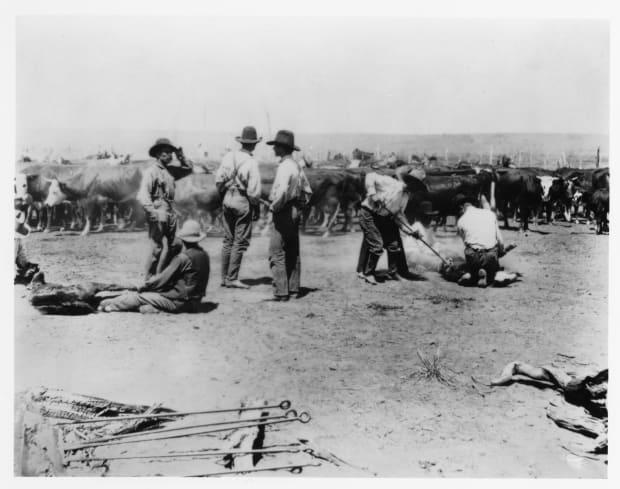
Photo: Levi Strauss & Co. Archives/Courtesy of Levi's
Strauss died in 1902. From then until World War II, the brand only made minor adjustments to the 501: adding two back pockets in 1901; switching from a "mock" felled inseam to a proper one in the 1910s; adding belt loops in 1922; adding the red tab on the back right pocket and stitching "Levi's" on the side in 1936; covering the rivets on the back pockets and removing the suspender buttons in 1937.
In 1927, Levi's began sourcing its red selvedge shrink-to-fit denim for the 501 from Cone Mills in Greensboro, North Carolina. (It would continue to do so until the mid-'80s, when it switched to more economical "wide loom" denim.)
Denim pants were becoming more and more popular outside of specific industries. Levi's had sponsored rodeos and featured cowboys in its marketing, making the brand synonymous with the Western look. And as dude ranches became popular vacation destinations, people outside of that world began to adopt the aesthetic. Meanwhile, down in Hollywood, movie stars like John Wayne wore Levi's in their films.
By this time — and especially after World War I — women wore pants more freely. In 1918, Levi's even released a one-piece, tunic-meets-balloon-pants garment made from cotton dubbed Freedom-Alls specifically for women. Almost two decades later, in 1935, introduced its first official jeans for women: the 701, or Lady Levi's, a higher-waisted style that borrowed its core features from the 501.
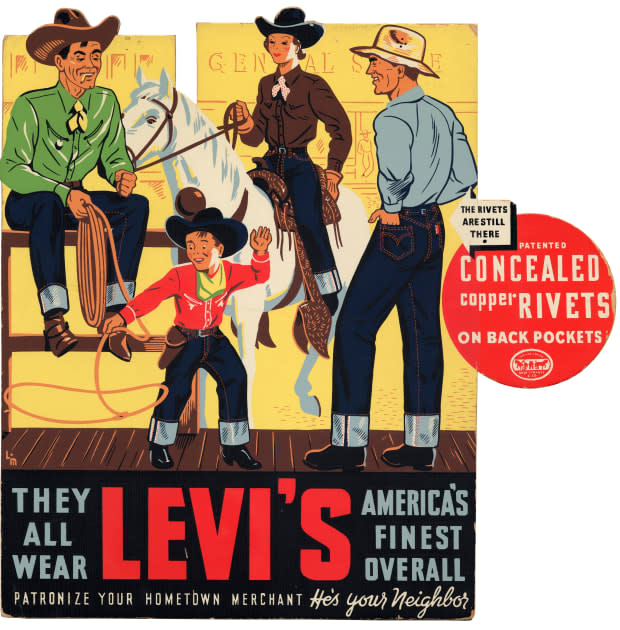
Photo: Levi Strauss & Co. Archives/Courtesy of Levi's
Around the same time, denim was also being marketed as play clothes for children or as something to wear to do chores, like gardening, according to FIT's Cole. However, there are also images of "bobby soxers" — early pop fans, from the '40s — in jeans, indicating that they were beginning to be embraced by teenage girls and young women, too, paving the way for their mega-popularity in the '50s.
The 501 in World War II: cutting costs
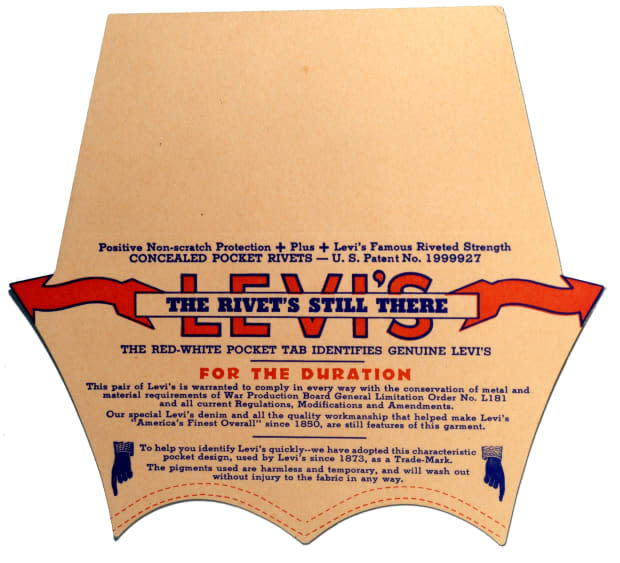
Photo: Levi Strauss & Co. Archives/Courtesy of Levi's
World War II, though, brought about the most significant disruption to and variation on the style.
Because of wartime rations, Levi's got rid of the cinch, the Arcuate stitching and the rivets on the crotch and watch pocket; it also swapped its buttons for generic ones. "Anything deemed unnecessary was removed," Panek says.
To maintain some sort of branding, it painted on the distinctive stitch pattern normally seen on its 501s and added a wartime "pocket flasher" label. (The cinch and the crotch rivet were axed permanently.)
Levi's historically maintained a strong presence in the American West, and had gotten product out across the Pacific to Hawaii, Japan, Australia and New Zealand. But World War II marked "the first time the 501 goes abroad on the folks that are wearing it, on the GIs heading to Europe and Asia wearing the 501," Panek says. "It's also the time when we start selling them on military bases."
Those same GIs kept wearing their 501s long after coming home from World War II, which propelled their popularity. "Many of them form motorcycle clubs and chose the 501, which makes a lot of sense because it's protective gear," Panek explains.
Post-war 501s: zippers and counter-culture
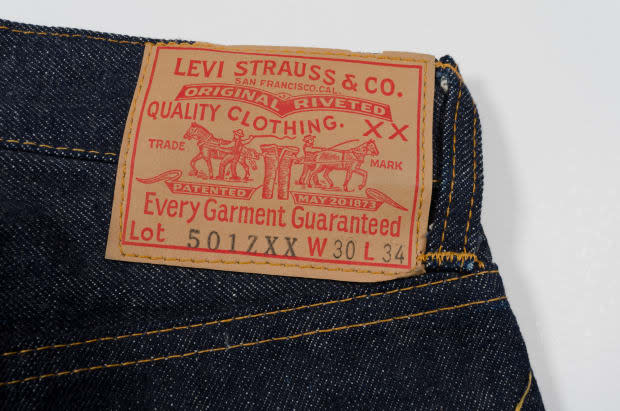
Photo: Levi Strauss & Co. Archives/Courtesy of Levi's
The 1950s represent another key turning point in the history of the 501.
For one, Levi's introduced one with a zipper closure, the 501Z. The brand also switched from a leather "Two Horse" patch to one made from heavy-duty card stock, and began playing with fit.
"Once we come out of World War II, you've got a much slimmer 501," Panek explains. "It's not that big overall that you would've had in those first few years, where people are pulling it up over their underwear or their long pants."
By the time we enter the '60s, the 501 was much more closely associated with rebels, artists and young people than its roots in workwear — something that was reinforced by pop culture, thanks to placements on Marlon Brando in "The Wild One" (1953), James Dean in "Rebel Without a Cause" (1955) and Marilyn Monroe in "Clash by Night" (1952) and "The Misfits" (1961). Around then, Levi's also stopped referring to the 501 as "overalls" in advertising and packaging, and began using the word the rest of the world used: jeans.
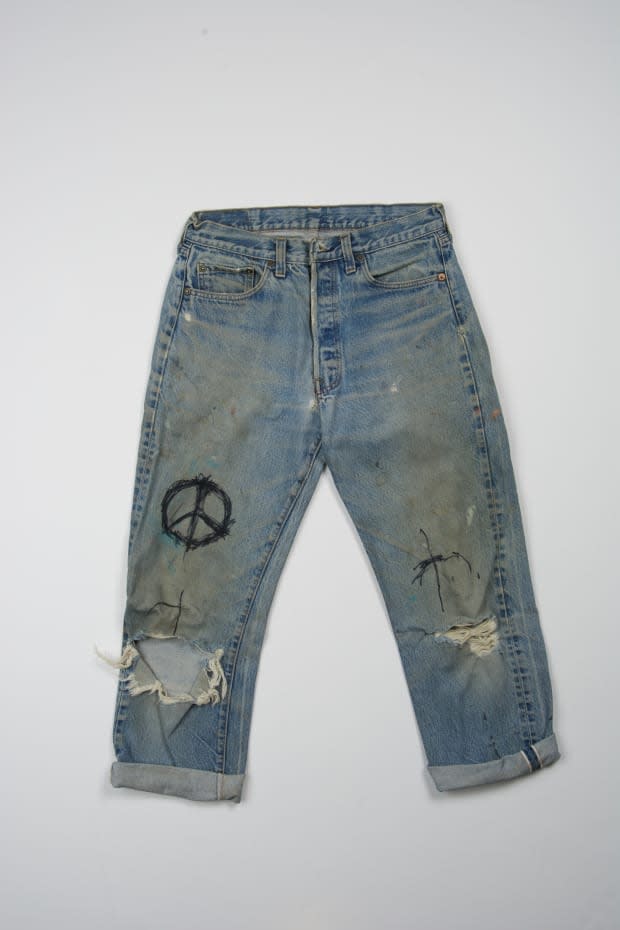
Photo: Levi Strauss & Co. Archives/Courtesy of Levi's
Denim played a big role in the proverbial social fabric of the U.S. in the 1960s. At that point, jeans were synonymous with counter-culture, and a "blue jean craze" took hold across the country. Then, during the Civil Rights Movement, many activists would wear denim to protests and demonstrations, turning jeans into a powerful political symbol. (See: Blue Jean Sunday, Dr. Martin Luther King, Jr. and Reverend Ralph Abernathy's matching denim when they were arrested in Birmingham in April 1963, the Student Nonviolent Coordinating Committee's uniform.)
It's around this time that the Smithsonian inducted the style into its permanent collection — a testament to the item's importance in history.
Because the style had been around for almost a century by that point, it became widely represented in the emerging secondhand market. "The idea of thrift-store finds really starts in this era, and 501s are a key part of it because they're easy to come by," Panek explains. "In the '60s, when so many young people are coming into San Francisco and other cities, they don't have a lot of money — sometimes they can go to places where they can get free clothes or flea markets."
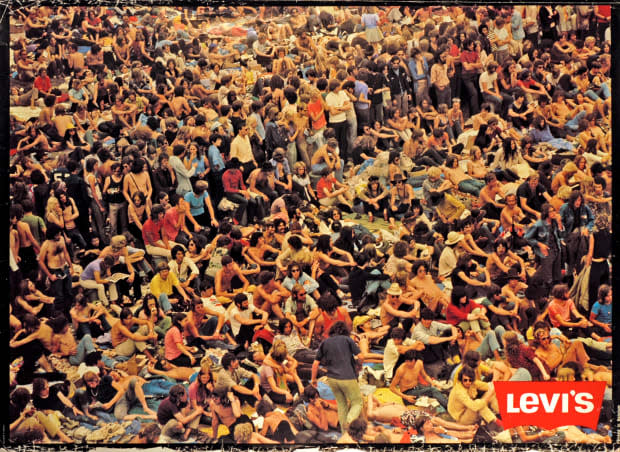
Photo: Levi Strauss & Co. Archives/Courtesy of Levi's
People would repair their used 501s and customize them with patches, embroideries and other alterations. While that mostly varied from individual to individual, sometimes those personalizations made it to Levi's HQ. Panek tells the story of Peggy Caserta, who had a boutique in San Francisco's Haight-Ashbury called Mnasidika and, around the Summer of Love, started noticing how folks were cutting up the sides of their 501s to flare out the hem. She starts making them, and — much like Davis and those pre-patent riveted pants — can't keep them in stock.
"So, she actually goes to Levi Straus and asks if they will help make some of these flared bell-bottom pants, which we do," Panek says.
In 1969, Levi's introduced its first bell-bottom, through its Orange Tab line, where the brand released most of its "fashion jeans" and other products outside of its core offering. Still, as Panek puts it: "A lot of the styles that happened, that Levi's eventually embraced, began on the street with an adaptation of the 501." In other words, the 501 remained the blueprint and North Star for Levi's.
From the 1970s onward, denim was a fashion item, with brands like Yves Saint Laurent, Calvin Klein, Gloria Vanderbilt, Maurice Sasson and many others now populating the "designer jeans" category. Even with more competition (and more price points), the 501 was a "baseline" for jeans, says Cole. And the industry recognized it: Levi's won a COTY Award — then the most prestigious fashion prize in the U.S., a predecessor for the CFDA Awards — in 1971 "for its 120‐year‐old American fashion work pants that evolved into blue jeans and now influence the world," according to a contemporaneous New York Times write-up.
According to Smithsonian Magazine, Levi's started exporting behind the Iron Curtain in 1978, its jeans becoming especially popular in East Berlin. When the Berlin Wall fell in 1989 and the company began selling its product more widely in the USSR, the 501 became a hot commodity.

Photo: Levi Strauss & Co. Archives/Courtesy of Levi's
Levi's, meanwhile, had grown massively from its origins as a wholesaler in San Francisco. By the 1980s, it was one of the largest apparel manufacturers in the U.S. Like most of its competitors, the company began closing factories stateside and taking its manufacturing abroad.
In 1981 — more than 50 years after Lady Levi's — Levi's released its first proper 501 for women. Around then, customers were beginning to want different finishes in denim, so the brand also introduced a variety of washes.
Marketing the 501
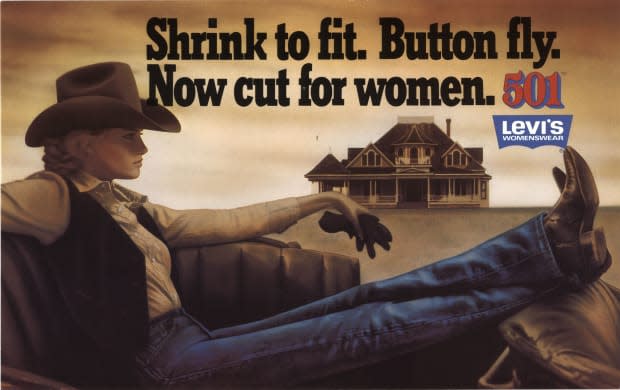
Photo: Levi Strauss & Co. Archives/Courtesy of Levi's
Like most great fashion stories, advertising played an important role in turning the 501 into an icon.
In the '80s, Levi's released some of the most consequential campaigns for the 501. The first notable one was the "Travis" commercial in 1981, to promote the 501 for women. Then, timed to the summer Olympics in Los Angeles in 1984, Levi's dropped its "501 Blues" ad spots, which featured then-emerging talent such as Bruce Willis, Jason Alexander and Stanley Tucci.
"The 501 becomes a household name thanks to advertising campaigns like that," Panek says.
The following decade, the brand worked with Spike Lee on a series of commercials that featured responses they received from a toll-free number that asked what they did in their 501s, called "Button Your Fly."
"The key to creating 'brand love' is you have to be authentic in the stories you tell and the people you work with," Chris Jackman, vice president of global brand marketing at Levi Strauss & Co., writes via e-mail. "We've focused on how the 501 truly embodies inclusion and authentic self-expression. From Nick Karmen in our Levi's 'Laundrette' ad in 1985 to Brad Pitt in 1990 to New Jeans as the face of the 501 in 2023, ads and the partners we work with have long played a large role in positioning the 501 as the brand's most iconic style."
For the 501's 150th, Levi's is telling "The Greatest Story Ever Worn," working with advertising agency Droga5 and with directors and cinematographers like Melina Matsoukas, Bradford Young, Martin de Thurah and Kasper Tuxen to create short films that show different parts of the style's story.
The 501's impact
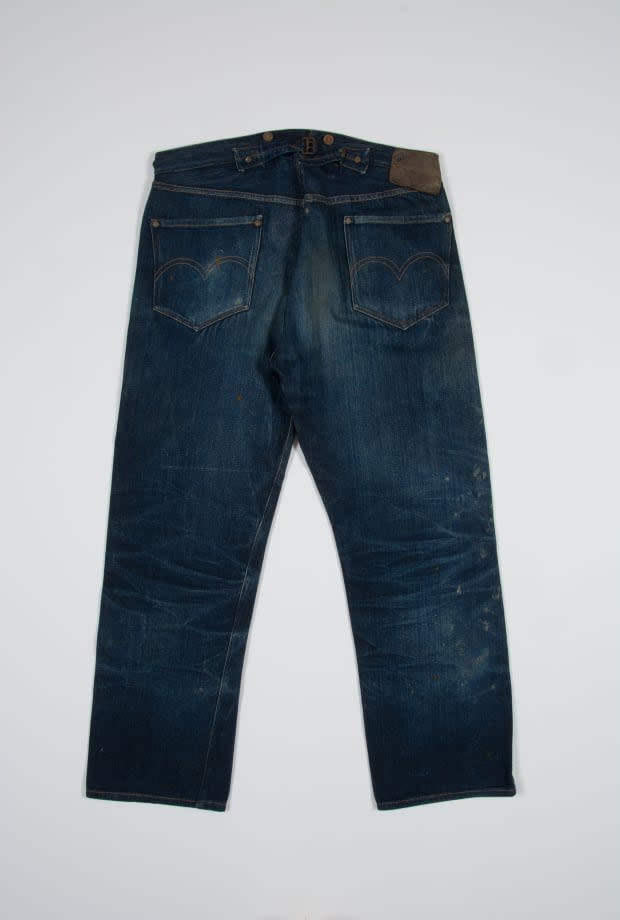
Levi's 501 from 1901. Photo: Levi Strauss & Co. Archives/Courtesy of Levi's
View the 6 images of this gallery on the original article
Over time, the 501 has been synonymous with cultural icons, from Patti Smith to Lauryn Hill to Steve Jobs. As such, it holds a powerful legacy, especially on the secondhand market, where it remains a favorite among shoppers: Vestiaire Collective's Hersan says "the vintage 501 is definitely the most sought after denim piece" on the platform.
"Today, 501 jeans are collected, repaired and cherished as a favorite piece of clothing in everyone's wardrobe," she argues. "Jeans are items that last because they meet both the physical and emotional durability that are key when picking a great fashion piece. She also notes that the majority of orders come from Europe, "showing the great impact the style had from its origins in the U.S. to other parts of the world."
Nowadays, the challenge Hillman and her team face is figuring out how to push the 501 forward without altering it. They balance trends and consumer desires and industry innovation with tradition, finding ways to build on the classic by bringing in new fabrics or incorporating fits from other decades. "We're really about getting that alchemy between heritage and modernity," says Hillman. "The 501 '81, for example, we pulled from the archive, but we had to modernize it, make sure that it fit for the times… We're making that archival garment for today."
Disclosure: Levi's paid for Fashionista's travel and accommodations to visit its San Francisco headquarters.
Please note: Occasionally, we use affiliate links on our site. In no way does this affect our editorial decision-making.
Never miss the latest fashion industry news. Sign up for the Fashionista daily newsletter.